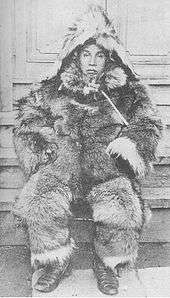Shirase Nobu

Shirase Nobu (白瀬 矗, July 20, 1861 – September 4, 1946) was a Japanese Army officer who led the Japanese Antarctic Expedition, 1910–12.
Early life
Shirase Nobu was born in Konoura, in Dewa Province (now Nikaho in Akita Prefecture) in July 20, 1861[1], the eldest child. According to his autobiography that he wrote after his Antarctic expedition, he was "impudent" during his childhood[1] . In his schooling years he read the Chinese classics and stories about the adventures of Christopher Columbus, Ferdinand Magellan, and John Franklin, and the latter third explorer inspired him to become an explorer of the Arctic.
At that time, his teacher Sasaki Sasasei taught him to follow five commitments:
- "I will not drink alcohol"
- "I will not smoke tobacco"
- "I will not drink tea"
- "I will not drink hot water"
- "Even in cold weather, I will not hit fire"
He enrolled in elementary school in 1877, and graduated in 1879. In July of the same year he considered being a priest, but two months later he joined the military.
From 1881 to 1905, Shirase trained himself for an expedition to the Arctic by exploring the Kuril Islands, after which he was involved in the Russo-Japanese War. After reading that Robert Peary had failed his Arctic expedition to find the North Pole in 1909, Shirase decided to change his planned expedition's course to the Antarctic.
Chishima Exploration
In 1881, Shirase completed an imperial Japanese army subordinate training program. He then joined the Transportation Corps and moved to Sendai. The next year, he went to Utsunomiya to participate in more army activity and met Kodama Gentaro[1]. In 1887 he married the daughter of a sea-based merchant[1] and was promoted to a senior officer assistant and transferred to a military reserve.In 1890, Shirase reunited with Kodama Gentaro in Sendai and talked about the thought of Arctic exploration, but Kodama was skeptical, "If you want to explore the Arctic, you should first explore Sakhalin or Kuril Island"[1]. Shirase joined the Chishima Exploration Party led by Meiji Gohji. While arriving in the Chishima islands, a heavy rainstorm had caused a disaster resulting in 19 deaths. 9 members were left behind at the Shiashkotan islands, and 1 by the Paramushir. August 31 of 1893 the group finally arrived at Shumshu, the northernmost island of the Chishima chain[1]. By the next May one more person died of Scurvy. In June, a Japanese warship docked at Shumshu. After 4 more members died and 5 disappeared, the group wished to return home on the ship, as was the district leader's plan. However the father of the district leader did not want the Chishima island expedition interrupted, and insisted the party remain on the island. After a cruel winter the district leader eventually consented to the return of the group. Shirase was one of four people who contracted scurvy, and the only one who survived it. Due to the disease Shirase lost strength and became unable to search for food. Out of necessity he shot and ate his pet dog in order to ward off starvation. By the time aid arrived, Shirase was no longer fit to participate in the first Sino-Japanese war. Shirase came to hold a grudge against the district leader and his family, and from that time after their relationship would only deteriorate[1].
Antarctic exploration
This expedition explored the coastal area of King Edward VII Land and the eastern part of the Ross Ice Shelf, reaching a latitude of 80°05'S. At one point, Shirase's men achieved an unexpected rendezvous with a party from the South Pole expedition led by Roald Amundsen.[2]
Shirase and his men were the first humans to make a landfall on the Edward VII Peninsula. Although the Shirase party were scorned in their departure to Antarctica, they were feted as heroes on their return to Japan. In 1936, an exhibition was held in his honor at the Tokyo Science Museum, where records of his exploration and samples of Antarctica were displayed, and Shirase held a speech.
Later life and death
In September 4, 1946, Shirase passed away in Koromo-cho (now part of Toyota City), Nishikamo District, in Aichi Prefecture.
Legacy
The Shirase Coast, located along the east side of the Ross Ice Shelf and the Ross Sea, was named after him by the New Zealand Antarctic Place-Names Committee in 1961.
Notes and references
Sources
- "Nobu Shirase, 1861–1946". www.south-pole.com. Retrieved 24 September 2008.
- Turney, Chris (2013), 1912: The Year The World Discovered Antarctica, Text Publishing, Melbourne.
- Ross, Chet (2010), Lieutenant Nobu Shirase and the Japanese Antarctic Expedition of 1910-1912: A Bibliography, Adelie Books, Santa Monica.
External links
- Our Global Neighbours: Nobu Shirase - an essay on the life, personality and achievements of Shirase.
- Sword of Friendship - an article by the Australian Museum, describing Shirase's gift of a 17th-century sword to Sir Tannatt William Edgeworth David in gratitude for his assistance during the expedition's stay in Sydney. The sword remains on display at the museum.
pop